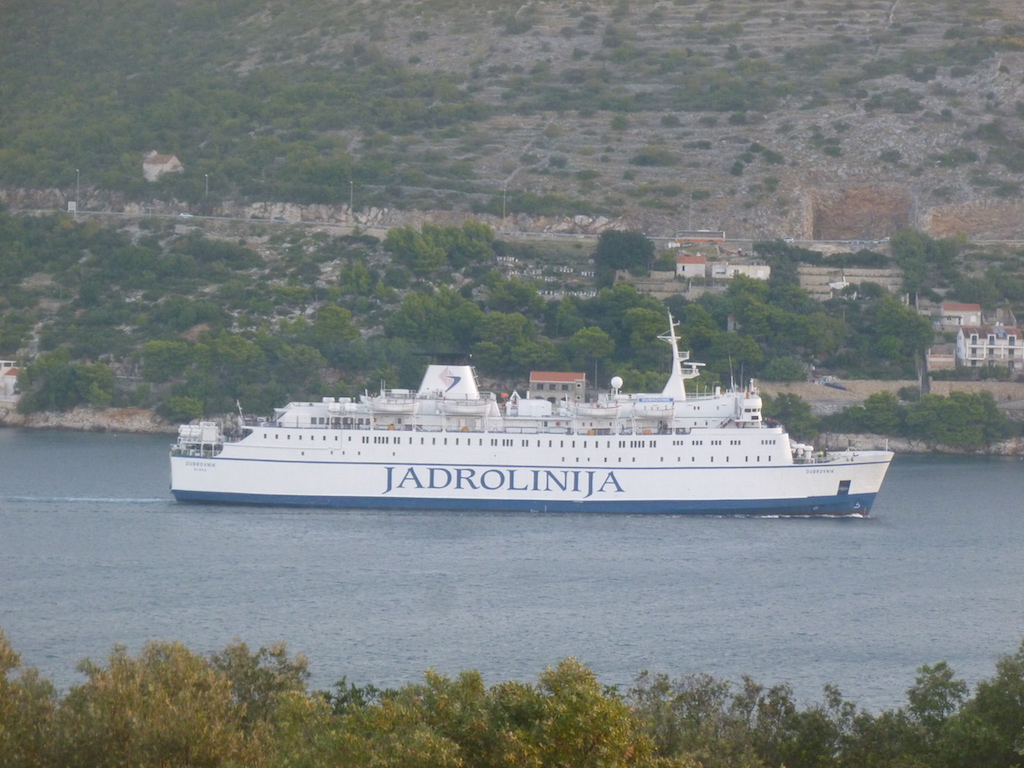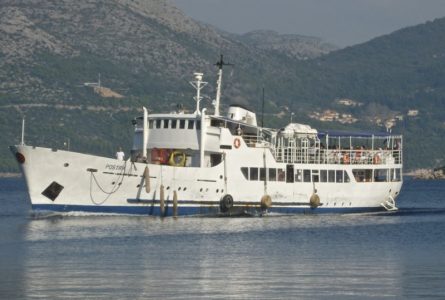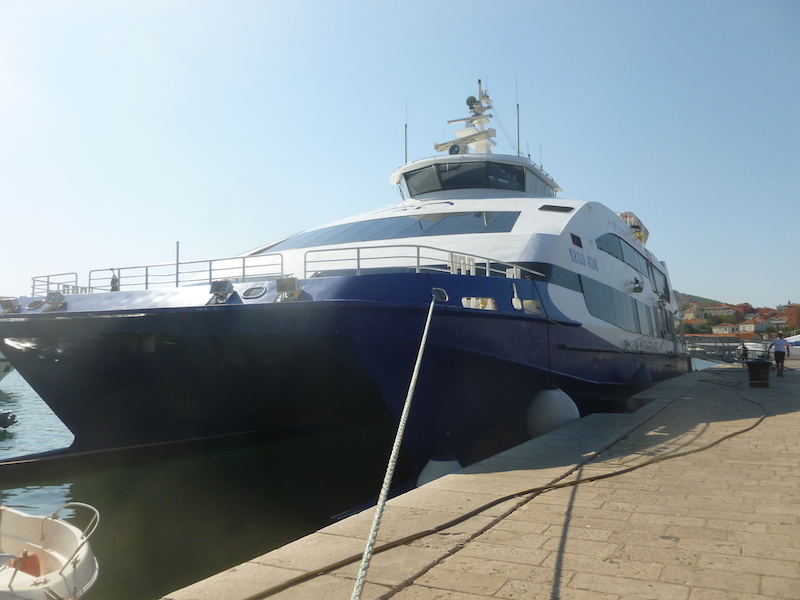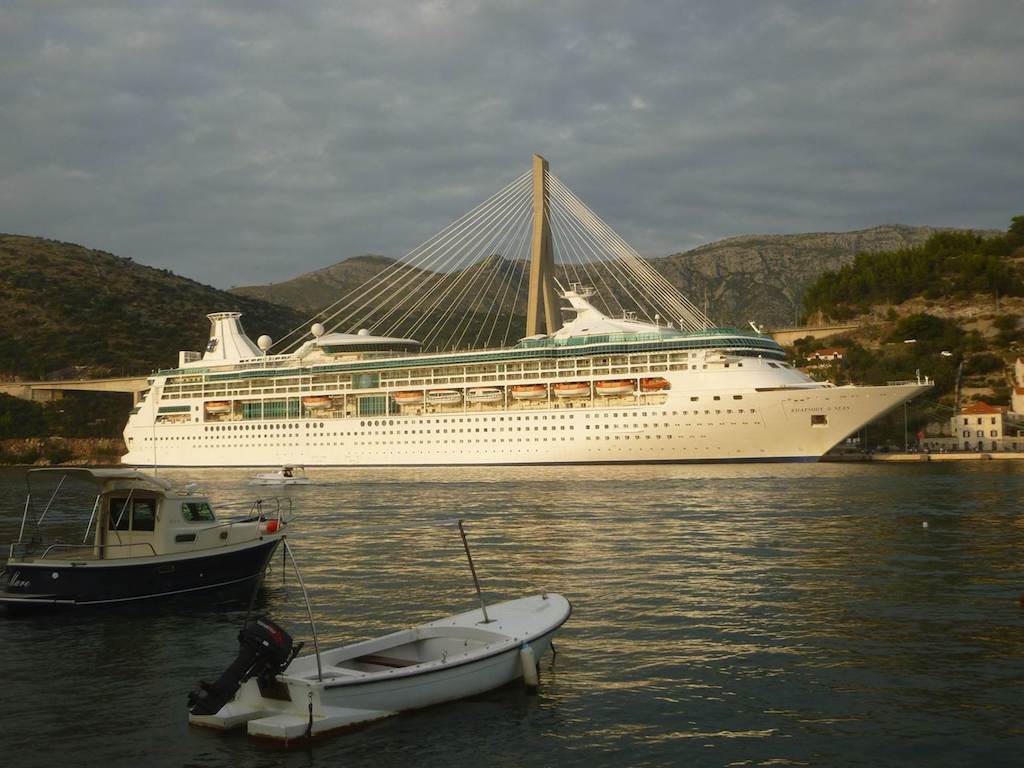
From his hotel balcony Colin Tucker saw all manner of craft, big and small, pass on their way in and out of Dubrovnik. Here we see the traditional passenger vessel Postira and the more modern-looking Brilo Star
Colin Tucker recommends sunny Dubrovnik on the Croatian coast as an antidote to Clyde and Hebridean ferry disruptions.
Where there are islands and sea there are usually ships and ferries. Dubrovnik, in southern Croatia, is no exception.
It is a beautiful walled medieval city, a UNESCO World Heritage site, which has been magnificently restored from its war-ravaged condition — the result of its siege in 1991 and 1992. When you have finished exploring the city walls and narrow streets, then you can head for the two ports which lie to the north and south of the old city.
The Old Port to the south is the more picturesque. Here are moored countless small motor boats and yachts. It is from here that you can make a variety of trips by water. There are small self-drive motor boats, and small glass-bottomed vessels will take you out to look at the marine life, or make a trip round the peninsula to the northern port. But of more interest are the two ferry services.
Otok Lokrum operates a half-hourly service to the island of Lokrum, the journey taking just 15 minutes. They have two ferries, named Skala and Zrinski, recognisable amongst all the other vessels milling about by their yellow funnels. At a glance they look different, but on closer inspection the only difference is that while the former’s wooden topsides are painted white, the latter vessel’s are varnished.
A slightly longer trip would take you along the coast to the small neighbouring resort of Cavtat. There are three companies operating this service, all vying for your custom on the pier. Some of the boats, operated by Adriane Cavtat, call at small jetties on the coast, at Srebreno, Mlini and Plat, and at Supetar island, near Cavtat.
The boat we sailed on went directly from the Old Port to Cavtat, the journey taking about an hour and costing roughly £10. The boats used are all similar, about 14 metres in length, with a wheelhouse behind which is seating for about 20 passengers, sheltered from the sun by a solid awning. Their appearance would appear to vary according to their age.
The north port, in the district of Gruz, is Dubrovnik’s commercial port. From here a variety of vessels sail along the coast to a number of islands, and to the mainland port of Split.
G & V Line operate a fast ferry, Nona Ana, to Mljet (one round trip daily, lasting an hour and 20 minutes) and to Lastovo (Tuesdays and Thursdays, two hours and 45 minutes). The length of the latter trip and the lack of open deck on the vessel persuaded us to make a shorter round trip, to Sudurad on the island of Sipan.
This island is visited by many visitors as part of the well-publicised ‘Three Islands Cruise’, advertised with time ashore at each island, time for swimming and a fish lunch on board – the typical Mediterranean tourist cruise. The cost was around £45. I discovered that there was a regular ferry following the same route, although it was not possible to have time ashore at more than one island.
Sudurad was the furthest island, the voyage taking an hour and a quarter. When we found out that the cost of the trip was about £4.50 for the return trip, our minds were made up. And how glad we were!
There were four return trips Mondays to Saturdays, and two on Sundays. The boat berthed overnight at Sudurad, so we decided to cross on the first sailing from Dubrovnik at 1000 and return on the 1520 sailing, getting us back to Dubrovnik at 1620. A later sailing would have brought us back at 1905, the last part of the journey being in darkness (we were there at the end of October).
There is also a car ferry service to two of the three islands (there being no cars on Kolocep, the nearest island to Dubrovnik). There are two sailings a day on Mondays, Wednesdays and Fridays, and one on Saturdays. This reflects the small number of vehicles on the islands. An interesting touch in the timetable was the information that if bad weather prevented sailings on Mondays and Wednesdays, the timetable would operate the day after.
The service is operated by Jadrolinija, a company which operates a number of ferries along the Croatian coast. The vessel is MV Postira, built in 1963, 335 gross tons, 44.6m in length, with a speed of 13 knots and capable of carrying 450 passengers. She is the last of the ‘famous 4P’ Jadrolinija ships; the other three were Porozina (scrapped 1988), Perast (war-damaged, scrapped in 2004) and Punat, which is now a floating restaurant.
Postira is a real ‘classic’ ship, with a slanting bow and pronounced sheer. She has a long open foredeck (with small cargo hatch) and passengers can still stand at the bow. Behind is the superstructure, above which is an open deck with awning housing traditional wooden slatted seats. From here it is possible to view the bridge and wheelhouse.
Below, on the main deck, is a small saloon with café-bar, from which steps lead down to a smaller lounge, and on this deck it is possible to view through open door and glass windows the slow-revving engines. It all brought back memories of days gone by on certain Clyde and West Highland ships. I was almost tempted to call her a steamer!
The day we travelled was a Saturday, and the ship soon became filled with passengers. They were mostly locals, some having come in on the first sailing and now returning laden with bags of shopping. Others came on board with luggage – islanders returning home for the weekend or to holiday homes. Everyone knew everyone else and the noise on the boat reflected the happy atmosphere.
The crew were busy loading boxes of supplies on to the fore deck. Almost to the scheduled sailing time, ropes were cast off and we were under way – but I had spoken too soon for there was a lot of shouting from the pier and engines were quickly reversed to allow a latecomer on board.
Speed is restricted in the port area, but once outside the chuntering of the engine increased and Kolocep was reached after 30 minutes.
The little jetty was thronged with people, there to greet arrivals, and no doubt just to see who was coming off the boat. Cargo was manhandled on to trolleys and wheeled on to dry land. We could have been at Tarbert or Raasay 50 years ago: it was very nostalgic.
On arrival at Sudurad we were able to see the car ferry Hannibal Lucic. She is a typical modern drive-through ferry, quite a contrast to Postira. Later we would watch her setting off on her afternoon sailing to Dubrovnik.

‘I could not commend my wife highly enough on her choice of hotel room’: the car ferry Hannibal Lucic passing a ‘pirate ship’ (on a ‘Three Islands’ cruise), viewed from the Tuckers’ room at Dubrovnik
I could not commend my wife highly enough on her choice of hotel room at Dubrovnik. From its balcony we could sit, with our glass of local wine, and watch the shipping passing in and out of the port. We got to know when to expect Postira and Hannibal Lucic, enjoying the sight of the former lit up as she made her late sailings. In the morning the modern ships would head north, returning later in the day.
Every second day a bigger Jadrolinija ship would arrive and leave the following day. She looked like a former British ship, and we soon discovered that she had originally been built in 1979 as the British & Irish ferry Connacht. Now carrying the name Dubrovnik, she operates a triangular service between Dubrovnik, Bari in Italy and Bar in Montenegro.
There was also the daily arrival and departure of the big cruise ships, such as Queen Victoria and Braemar. They would creep their way in, and we could see the tiny pilot boat scuttling alongside. It was truly a ship lover’s delight.
If you ever become tired of Clyde steamers, CalMac ferries and Scottish weather, I would certainly recommend a trip to Dubrovnik for some ferry therapy.
All photographs are © Colin Tucker

Traditional and modern lie alongside the pier at Sudurad on the Croatian coast – the passenger ship Postira and car ferry Hannibal Lucic

Skala, one of the two passenger ferries which ply regularly from the Old Port of Dubrovnik to the island of Lokrum

Room with a view: from his hotel Colin Tucker caught sight of the cross channel ferry Dubrovnik (ex Connacht) arriving from Bari in Italy
Click here to scroll down the entire library of CRSC website articles, including many by Colin Tucker on themes near and far.
Published on 21 March 2019




















